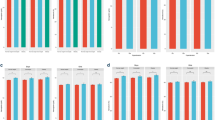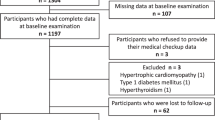Abstract
Uncontrolled pediatric hypertension may increase the risk of hypertension in adulthood. Several studies have reported an association between hematological parameters and blood pressure (BP) levels. However, epidemiologic evidence of this association in children and adolescents remains scarce. This study aims to explore the associations between hematological parameters and the incidence of prehypertension and hypertension in children and adolescents. This longitudinal study was conducted with 1368 participants aged 6–8 years from baseline visit to follow-up visit. Compared with participants from the normal blood pressure (BP) group, participants from the elevated BP group had significantly higher baseline red blood cell (RBC) counts, hemoglobin (Hb) counts and hematocrit (Hct) levels (all P < 0.001). A multilevel linear mixed model was conducted to analyze the relationship between hematological parameters and BP levels. The results suggested that SBP, DBP and MAP increased significantly with a quartile increase of levels of hematological parameters (all P < 0.05). Furthermore, a multilevel mixed logistic regression model was used to analyze the risk of per interquartile range increase in hematological parameters on the incidence of prehypertension and hypertension. The risk of prehypertension and hypertension incidence increased by (1.34 (95%CIs: 1.20, 1.50)), (1.38 (95%CIs: 1.24,1.54)), (1.33 (95%CIs: 1.19,1.50)), (1.14 (95%CIs: 1.03,1.26)) fold with a one-quartile increase in levels of RBC, Hb, Hct and Fe, respectively (all P < 0.05). This longitudinal study showed that hematological parameters were positively associated with BP levels in healthy children and adolescents, which excluded the effect of antihypertensive drugs on BP levels that often appeared in adults.

This is a preview of subscription content, access via your institution
Access options
Subscribe to this journal
Receive 12 print issues and online access
$259.00 per year
only $21.58 per issue
Buy this article
- Purchase on Springer Link
- Instant access to full article PDF
Prices may be subject to local taxes which are calculated during checkout


Similar content being viewed by others
Data availability
The datasets analyzed during the current study available from the corresponding author on a reasonable request.
References
Din-Dzietham R, Liu Y, Bielo M, Shamsa F. High blood pressure trends in children and adolescents in national surveys, 1963 to 2002. Circulation. 2007;116:1488–96.
Flynn J. The changing face of pediatric hypertension in the era of the childhood obesity epidemic. Pediatr Nephrol (Berl, Ger). 2013;28:1059–66.
Liang X, Chen M, Qu P, Hao G, Huang Y, Chen J, et al. The Association of Vitamin A and Vitamin D with Hypertension in Children: A Case-Control Study. Int J Hypertens. 2018;2018:9295147.
Meng L, Liang Y, Liu J, Hu Y, Yan Y, Mi J. Prevalence and risk factors of hypertension based on repeated measurements in Chinese children and adolescents. Blood Press. 2013;22:59–64.
Hardy ST, Sakhuja S, Jaeger BC, Urbina EM, Suglia SF, Feig DI, et al. Trends in Blood Pressure and Hypertension Among US Children and Adolescents, 1999-2018. JAMA Netw Open. 2021;4:e213917.
Liang X, Chen J, An X, Liu F, Liang F, Tang X, et al. The impact of PM2.5 on children’s blood pressure growth curves: A prospective cohort study. Environ Int. 2022;158:107012.
Chen XT, Yang S, Yang YM, Zhao HL, Chen YC, Zhao XH, et al. Exploring the relationship of peripheral total bilirubin, red blood cell, and hemoglobin with blood pressure during childhood and adolescence. J Pediatr (Rio J). 2018;94:532–8.
Cirillo M, Laurenzi M, Trevisan M, Stamler J. Hematocrit, blood pressure, and hypertension. The Gubbio Population Study. Hypertension (Dallas, Tex: 1979). 1992;20::319–26.
Jeong HR, Shim YS, Lee HS, Hwang JS. Hemoglobin and hematocrit levels are positively associated with blood pressure in children and adolescents 10 to 18 years old. Sci Rep. 2021;11:19052.
Lee DH, Kang SK, Choi WJ, Kwak KM, Kang D, Lee SH, et al. Association between serum ferritin and hypertension according to the working type in Korean men: the fifth Korean National Health and nutrition examination survey 2010-2012. Ann Occup Environ Med. 2018;30:40.
Merad-Boudia H, Dali-Sahi M, Kachekouche Y, Dennouni-Medjati N. Hematologic disorders during essential hypertension. Diabetes Metab Syndr. 2019;13:1575–9.
Piperno A, Trombini P, Gelosa M, Mauri V, Pecci V, Vergani A, et al. Increased serum ferritin is common in men with essential hypertension. J Hypertens. 2002;20:1513–8.
Zhu Y, Chen G, Bo Y, Liu Y. Markers of iron status, blood pressure and incident hypertension among Chinese adults. Nutr Metab Cardiovasc Dis. 2019;29:830–6.
Merad-Boudia HN, Dali-Sahi M, Kachekouche Y, Dennouni-Medjati N. Hematologic disorders during essential hypertension. Diabetes Metab Syndr. 2019;13:1575–9.
Cirillo M, Laurenzi M, Trevisan M, Stamler J. Hematocrit, blood pressure, and hypertension. The Gubbio Population Study. Hypertension. 1992;20:319–26.
Liang X, Xiao L, Luo Y, Xu J. Prevalence and risk factors of childhood hypertension from birth through childhood: a retrospective cohort study. J Hum Hypertens. 2020;34:151–64.
Liang X, Xiao L, Luo Y, Xu J. Prevalence and Risk Factors of Childhood Hypertension in Urban-Rural Areas of China: A Cross-Sectional Study. Int J Hypertens. 2020;2020:2374231.
Patel A, Bharani A, Sharma M, Bhagwat A, Ganguli N, Chouhan D. Prevalence of hypertension and prehypertension in schoolchildren from Central India. Ann Pediatr Cardiol. 2019;12:90–6.
Liang X, Xiao L, Chen J, Qu P, Tang X, Wang Y. The Determinants of Adolescent Glycolipid Metabolism Disorder: A Cohort Study. Int J Endocrinol. 2022;2022:6214785.
Lee SG, Rim JH, Kim JH. Association of hemoglobin levels with blood pressure and hypertension in a large population-based study: the Korea National Health and Nutrition Examination Surveys 2008-2011. Clin Chim Acta. 2015;438:12–8.
Liu D, Wang C, Zhang Y, Zuo H. Gender differences in the associations of circulating erythrocytes and hemoglobin with hypertension risk. Blood Press Monit. 2022;27:227–32.
Song JJ, Ma Z, Wang J, Chen LX, Zhong JC. Gender Differences in Hypertension. J Cardiovasc Transl Res. 2020;13:47–54.
Gladwin MT, Crawford JH, Patel RP. The biochemistry of nitric oxide, nitrite, and hemoglobin: role in blood flow regulation. Free Radic Biol Med. 2004;36:707–17.
Di Giosia P, Giorgini P, Stamerra CA, Petrarca M, Ferri C, Sahebkar A. Gender Differences in Epidemiology, Pathophysiology, and Treatment of Hypertension. Curr Atheroscler Rep. 2018;20:13.
Fischer M, Baessler A, Schunkert H. Renin angiotensin system and gender differences in the cardiovascular system. Cardiovasc Res. 2002;53:672–7.
Komukai K, Mochizuki S, Yoshimura M. Gender and the renin-angiotensin-aldosterone system. Fundam Clin Pharm. 2010;24:687–98.
Link J, Reue K. Genetic Basis for Sex Differences in Obesity and Lipid Metabolism. Annu Rev Nutr. 2017;37:225–45.
Enawgaw B, Adane N, Terefe B, Asrie F, Melku M. A comparative cross-sectional study of some hematological parameters of hypertensive and normotensive individuals at the university of Gondar hospital, Northwest Ethiopia. BMC Hematol. 2017;17:21.
Sileshi B, Urgessa F, Wordofa M. A comparative study of hematological parameters between hypertensive and normotensive individuals in Harar, eastern Ethiopia. PloS ONE. 2021;16:e0260751.
Tong J, An X, Zhao L, Qu P, Tang X, Chen M, et al. Combining multiaspect factors to predict the risk of childhood hypertension incidence. J Clin Hypertens (Greenwich, Conn). 2022;24:1015–25.
Atsma F, Veldhuizen I, de Kort W, van Kraaij M. Pasker-de Jong P, Deinum J: Hemoglobin level is positively associated with blood pressure in a large cohort of healthy individuals. Hypertension. 2012;60:936–41.
Lee S, Rim J, Kim J. Association of hemoglobin levels with blood pressure and hypertension in a large population-based study: the Korea National Health and Nutrition Examination Surveys 2008-2011. Clin Chim Acta; Int J Clin Chem. 2015;438:12–8.
Shimizu Y, Nakazato M, Sekita T, Kadota K, Arima K, Yamasaki H, et al. Association between the hemoglobin levels and hypertension in relation to the BMI status in a rural Japanese population: the Nagasaki Islands Study. Intern Med. 2014;53:435–40.
Kim NH, Lee JM, Kim HC, Lee JY, Yeom H, Lee JH, et al. Cross-sectional and longitudinal association between hemoglobin concentration and hypertension: A population-based cohort study. Med (Baltim). 2016;95:e5041.
Bian K, Doursout MF, Murad F. Vascular system: role of nitric oxide in cardiovascular diseases. J Clin Hypertens (Greenwich). 2008;10:304–10.
Cabrales P, Han G, Nacharaju P, Friedman AJ, Friedman JM. Reversal of hemoglobin-induced vasoconstriction with sustained release of nitric oxide. Am J Physiol Heart Circ Physiol. 2011;300:H49–56.
Devereux R, Case D, Alderman M, Pickering T, Chien S, Laragh J. Possible role of increased blood viscosity in the hemodynamics of systemic hypertension. Am J Cardiol. 2000;85:1265–8.
Kawamoto R, Tabara Y, Kohara K, Miki T, Kusunoki T, Katoh T, et al. A slightly low hemoglobin level is beneficially associated with arterial stiffness in Japanese community-dwelling women. Clin Exp Hypertens. 2012;34:92–8.
Emamian M, Hasanian SM, Tayefi M, Bijari M, Movahedian Far F, Shafiee M, et al. Association of hematocrit with blood pressure and hypertension. J Clin Lab Anal. 2017;31:e22124.
Nakanishi N, Yoshida H, Okamoto M, Nakamura K, Uzura S, Suzuki K, et al. Hematocrit and risk for hypertension in middle-aged Japanese male office workers. Ind Health. 2001;39:17–20.
Soranzo N, Spector TD, Mangino M, Kühnel B, Rendon A, Teumer A, et al. A genome-wide meta-analysis identifies 22 loci associated with eight hematological parameters in the HaemGen consortium. Nat Genet. 2009;41:1182–90.
Kato N. Ethnic differences in genetic predisposition to hypertension. Hypertens Res. 2012;35:574–81.
Acknowledgements
The authors thank the Ministry of Education Key Laboratory of Child Development and Disorders and all of the staff members of the six elementary schools in the two regions of the study for their support.
Funding
This work was supported by, National Clinical Research Center for Child Health and Disorders (No. NCRCCHD-2022-GP-01, NCRC-2020-GP-13, NCRCCHD-2020-GP-10), the Research and Innovation Team of Chongqing Medical University (No. W0088), Chongqing Science and Technology Bureau (No. CSTC2021jscx-gksb-N0001), Young and Middle-aged Medical Outstanding Expert Project of Chongqing Municipal Health Commission (No. 78), National Key Research and Development Project (No. 2017YFC0211705), Intelligent Medicine Project (No. ZHYX202109), Natural Science Foundation of Youth Project (No. 81502826), Key project of Innovation and Development united Fund of Chongqing Natural Science Foundation (CSTB2022NSCQ-LZX0029) and Education Commission of Chongqing Municipality (No. KJQN201900443). The funders had no role in the study design, the data collection and analysis, the decision to publish, or the preparation of the paper.
Author information
Authors and Affiliations
Contributions
XHL conceived and designed the experiments; LH, XYL, CS and QL participated the data analysis and drafted the paper; DCH, XMG, and XZA participated in the epidemiological investigation; YLR, LH, and QL participated in the data collection. All authors read and approved the final paper.
Corresponding author
Ethics declarations
Conflict of interest
The authors declare no competing interests.
Ethics approval and consent to participate
The Institutional Review Board of the Children’s Hospital of Chongqing Medical University approved this study. Informed consent to participate in this study was provided by all of the subjects and their parents/guardians.
Consent for publication
All the authors have critically reviewed and approved the publication of the final paper.
Additional information
Publisher’s note Springer Nature remains neutral with regard to jurisdictional claims in published maps and institutional affiliations.
Rights and permissions
Springer Nature or its licensor (e.g. a society or other partner) holds exclusive rights to this article under a publishing agreement with the author(s) or other rightsholder(s); author self-archiving of the accepted manuscript version of this article is solely governed by the terms of such publishing agreement and applicable law.
About this article
Cite this article
Huang, L., Song, C., Liu, Q. et al. The associations between hematological parameters and the incidence of prehypertension and hypertension in children and adolescents: a prospective cohort study. Hypertens Res 46, 2085–2099 (2023). https://doi.org/10.1038/s41440-023-01304-z
Received:
Revised:
Accepted:
Published:
Issue Date:
DOI: https://doi.org/10.1038/s41440-023-01304-z



